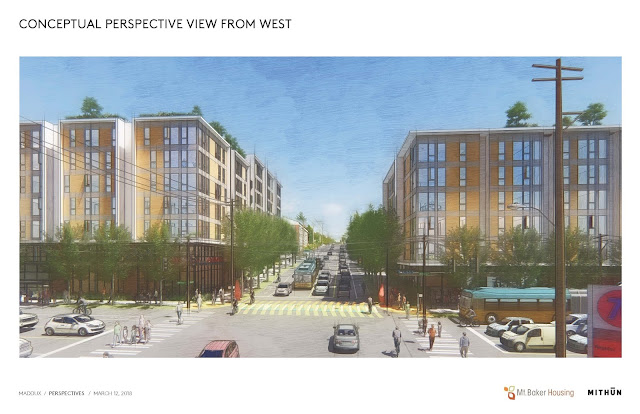A pair of
street corners in southeast Seattle may not look like much right now, but
they’re already a first-of-its-kind cleanup site for Ecology. Yet, it’s a
contaminated site much like hundreds before it that have undergone cleanup and been
put to new use. We’re opening a public comment period
on a cleanup plan that marks an important an important step forward.
 |
The Maddux
will provide affordable housing and street-level shops about a block from a
Link light rail station.
Illustration courtesy of Mount Baker Housing Association.
|
A first
The Mount Baker Housing Association’s Maddux project
is the inspiration for Washington’s Healthy
Housing Remediation Program, which we developed in conjunction with the Washington State
Department of Commerce. The program enables local governments and nonprofit organizations to obtain
state funding to help offset environmental cleanup costs when redeveloping
contaminated land for affordable housing.
Mount Baker
acquired a cluster of lots where S. McClellan Street intersects with Martin
Luther King Way S. The association plans 166 affordable units with street level
retail a block from Sound Transit’s Mount Baker Link light rail station and
near a variety of shopping and services.
Overcoming a common obstacle
These plans overlap
with a costly problem that’s common to urban redevelopment. Previous use of the
property – in this case a gas station and a dry cleaner – left contamination
behind. The remediation program, building on earlier funding we’ve provided for
the project’s cleanup, has enabled Mount Baker to proceed with more than $6
million in state assistance to hire consultants who evaluated the
contamination, sifted through cleanup options and worked with us to propose a
cleanup plan.
 |
The former
gas station at Martin Luther King and McClellan. The former dry cleaner is
across McClellan at far left. Ecology photo.
|
We’re asking
the public, as part of the state Model
Toxic Control Act cleanup process, to review those studies, the plan,
proposed updates to our legal agreement with Mount Baker, and environmental
review documents we’ve prepared.
That comment period runs
through November 26, 2019.
Historic
releases from gas stations and dry cleaners are the most common types of
cleanup sites in Washington. Current laws on handling cleaning chemicals and
managing underground storage tanks prevent these problems at today’s cleaners
and fill-up stations.
A cleanup plan that fits the project
The gas
station cleanup will primarily involve excavation of soil in and around areas
where underground tanks and system piping once were.
The dry
cleaner’s contamination requires a more complex approach. The solvents that
were used mix readily into water. Even a small spill or leak into the ground
can spread over a wide area if it enters the flow of groundwater. That’s what
happened here (see the map below), and the Maddux development will incorporate
features that factor in a cleanup process that may continue for several years.
Excavation
of the contaminated soil under the dry cleaner and adjacent parcels will remove
the source of the groundwater contamination. This will help slow or stop the
expansion of the plume of solvent-contaminated groundwater that extends under S.
McClellan Street, part of the former gas station and under an adjoining
stretch of Martin Luther King Way S.
The rest of
the plan allows the project to proceed and cleanup to continue without
disrupting traffic on the two streets:
- Because the solvent compounds can release vapor that can rise through the soil, the project will be engineered with capping, vapor barriers and sub-slab ventilation. The property deed will prohibit future modifications that change these protections without notifying us and obtaining our approval.
- Long term monitoring will provide information on how well the cleanup treatments are working and track the breakdown of the solvents.
- After 5 years of monitoring, the time to reach cleanup in the groundwater will be recalculated. If it is determined to be too slow, Mount Baker will inject a chemical (such as zero valent iron) into the groundwater that aids in the breakdown the contaminants. Bacteria that’s naturally present in soil also helps by feeding on the solvent chemicals, breaking them down biologically.
We will
review the monitoring data and the condition of the site every five years to
determine how well the plan is working and whether any changes are needed. We’ll
issue a report on these periodic reviews and ask for public comment each time.
 |
Technicians
for a consulting firm drill below the floor
of a former dry cleaner to gather
environmental samples.
Photo courtesy of Mount Baker Housing Association.
|
Public meeting
Along with
the comment period, we’re hosting a public meeting and open house. Our cleanup
experts will be there, along with representatives from Mount Baker and their
environmental consultants.
- Wed., Nov. 6, 2019; 6-8 p.m.
- Mt Baker Village Meeting Room
- 2580 29th Ave. S.
We’ll have
displays about the project and the cleanup plan and will be glad to discuss the
cleanup and answer questions. We’ll also give a presentation and take audience
questions. Translation and interpreter services will be available in Spanish,
Chinese, Vietnamese, and Khmer.
By: Larry
Altose, Northwest regional communications manager
More information:
The documents out for comment:
- Remedial Investigation / Feasibility study
- Draft Cleanup Action Plan
- State Environmental Protection Act checklist and Determination of Non-significance
A fact sheet about the project's cleanup process is available in Chinese, English, Khmer, Spanish and Vietnamese.
Other links:
- Maddux project cleanup information
- Comment on the cleanup plan and related documents
- Focus on: Healthy Housing Remediation Program (pdf)
- How we help with affordable housing-related cleanups
- Cleaning up: Investing in communities to turn blighted properties into affordable housing, March 14, 2019


No comments:
Post a Comment